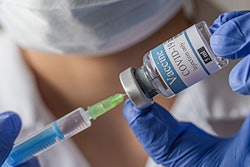
As COVID-19 vaccinations become readily available, mammographers must be alert for the possibility that a recent COVID-19 vaccination may be responsible for patients with unilateral axillary adenopathy.
 Dr. Kristy Wolfel of Cambria Somerset Radiology.
Dr. Kristy Wolfel of Cambria Somerset Radiology.New research suggests that patients receiving either the Pfizer-BioNTech or Moderna COVID-19 vaccine may experience swollen lymph nodes that could be mistaken as a malignancy, according to a study published January 18 in Clinical Imaging.
The article cites four case studies found by researchers at NewYork-Presbyterian/Weill Cornell Medical Center in which patients experienced unilateral axillary adenopathies after receiving their first COVID-19 vaccination.
It's imperative to consider differential benign diagnoses to avoid unnecessary additional testing and to avoid extra stress for the patient.
Details of the recent case studies
Among the four case studies, patients either had palpable unilateral adenopathy, or the node was discovered during screening mammography or ultrasound. All four women received early COVID-19 vaccinations due to their 1a status. The four patients included the following:
- A 59-year-old woman presented with a palpable lump in the left axilla. Although she had no history of breast cancer, her sister had been diagnosed with breast cancer at age 53. The patient's left breast mammogram was unremarkable. However, a left axillary lymph node measuring 2.6 x 1.5 x 1.6 cm was detected by sonography. Her right axillary lymph node was normal. The patient stated that she noticed the lump nine days after receiving her first dose of the Pfizer-BioNTech COVID-19 vaccine in her left arm.
- A 42-year-old woman came for routine mammography and ultrasound. She had no personal history of breast cancer, but one of her grandmothers was diagnosed with breast cancer at age 80. The patient's screening mammography was unremarkable; however, her ultrasound revealed several left axillary lymph nodes with thickened cortices, the largest being 2.7 x 1.2 x 1 cm. Her electronic medical record showed that she had received her second dose of the Pfizer-BioNTech COVID-19 vaccine in her left arm five days prior to screening.
- A 42-year-old woman with suspected bilateral masses reported for sonography to evaluate those masses. Not only did the patient have stable hypoechoic breast masses but her left axillary lymph node had cortical thickening. However, her right axillary lymph nodes were normal. When discussing her results with the physician, the patient disclosed that she had received her first dose of the Moderna COVID-19 vaccine in her upper left arm 13 days prior.
- A 57-year-old woman with no personal or family history of breast cancer came for her routine screening. Her bilateral mammography was unremarkable; however, the ultrasound displayed a left axillary lymph node with cortical thickening, measuring 1 cm. Her right axillary lymph nodes were normal. The sonographer noted from the patient's electronic medical record that she had received her first dose of the Pfizer-BioNTech COVID-19 vaccine eight days prior.
Each of these patients was scheduled for a follow-up targeted ultrasound to ensure resolution.
Unilateral axillary adenopathy may indicate the presence of breast cancer or benign medical conditions. Targeted ultrasound should be scheduled four to 12 weeks after the patient's second COVID-19 vaccine dose.
How common is adenopathy after vaccination?
Mammographers will face an uptick in differential diagnoses in 2021 as the U.S. COVID-19 vaccination program ramps up to include the broader population. As the program expands to include essential workers, mammographers will face a diverse population, including many patients who are uninsured, underinsured, or unemployed because of the virus.
Unilateral axillary adenopathy is not an uncommon occurrence after vaccination. Adenopathy is well documented after anthrax, tuberculosis, and smallpox vaccine administration. Sometimes, patients are misdiagnosed as having blood cancer.
Unilateral axillary adenopathy has also happened after the H1N1 influenza A virus vaccine. Recently, the HPV has been associated with unilateral adenopathy in the ipsilateral deltoid muscle. Adenopathy is associated most closely with vaccines that produce a robust immune response.
The U.S. Centers for Disease Control and Prevention (CDC) records show that Moderna reported that axillary adenopathy was the second most experienced local reaction in patients ages 18 to 64 -- occurring in 11.6% of patients after their first dose and in 16% after their second dose.
However, the CDC does not show data regarding axillary adenopathy for the Pfizer-BioNTech vaccine. Instead, it reported that adenopathy reactions were imbalanced between patients who received the vaccine (64) and those who received the placebo (6). The CDC concluded that it was reasonable to believe that the adenopathy was related to the vaccine.
Based on the CDC's data and these studies, axillary adenopathy can occur from two to four days after vaccination to several weeks after vaccination. Duration of the adenopathy ranges from one or two days up to 10 days. However, it is not yet known if these numbers will hold once millions of people are vaccinated.
The takeaway
Radiologists must now consider a patient's recent COVID-19 vaccination history as a possible differential diagnosis when unilateral axillary adenopathy is detected. Adenopathy may be discovered during scheduled imaging, or patients may discover the adenopathy and ask for diagnostic imaging. Regardless of the method of detection, COVID-19 vaccination history must be considered to avoid patient harm and costs.
In the case of unilateral axillary adenopathy occurring after a recent COVID-19 vaccination, researchers suggest a follow-up targeted ultrasound four to 12 weeks after the patient's second vaccine dose. If the node remains swollen, an ultrasound-guided core needle biopsy would likely be the most appropriate next step.
Mammographers should ensure that breast imaging technicians ask about each patient's recent vaccination history. Radiologists should also inform referring physicians about adenopathy as a potential local reaction to COVID-19 vaccinations. Finally, notices to inform patients should be posted to help avoid undue anxiety.
Dr. Kristy Wolfel is a radiologist at Cambria Somerset Radiology.
The comments and observations expressed are those of the author and do not necessarily reflect the opinions of AuntMinnie.com.



















